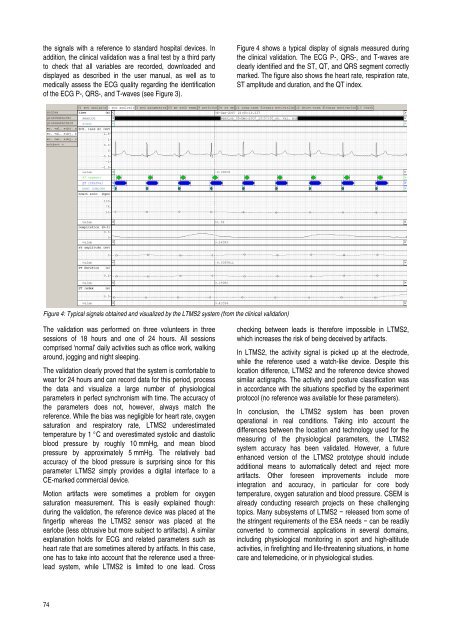research activities in 2007 - CSEM
research activities in 2007 - CSEM
research activities in 2007 - CSEM
You also want an ePaper? Increase the reach of your titles
YUMPU automatically turns print PDFs into web optimized ePapers that Google loves.
the signals with a reference to standard hospital devices. In<br />
addition, the cl<strong>in</strong>ical validation was a f<strong>in</strong>al test by a third party<br />
to check that all variables are recorded, downloaded and<br />
displayed as described <strong>in</strong> the user manual, as well as to<br />
medically assess the ECG quality regard<strong>in</strong>g the identification<br />
of the ECG P-, QRS-, and T-waves (see Figure 3).<br />
Figure 4: Typical signals obta<strong>in</strong>ed and visualized by the LTMS2 system (from the cl<strong>in</strong>ical validation)<br />
The validation was performed on three volunteers <strong>in</strong> three<br />
sessions of 18 hours and one of 24 hours. All sessions<br />
comprised ‘normal’ daily <strong>activities</strong> such as office work, walk<strong>in</strong>g<br />
around, jogg<strong>in</strong>g and night sleep<strong>in</strong>g.<br />
The validation clearly proved that the system is comfortable to<br />
wear for 24 hours and can record data for this period, process<br />
the data and visualize a large number of physiological<br />
parameters <strong>in</strong> perfect synchronism with time. The accuracy of<br />
the parameters does not, however, always match the<br />
reference. While the bias was negligible for heart rate, oxygen<br />
saturation and respiratory rate, LTMS2 underestimated<br />
temperature by 1 °C and overestimated systolic and diastolic<br />
blood pressure by roughly 10 mmHg, and mean blood<br />
pressure by approximately 5 mmHg. The relatively bad<br />
accuracy of the blood pressure is surpris<strong>in</strong>g s<strong>in</strong>ce for this<br />
parameter LTMS2 simply provides a digital <strong>in</strong>terface to a<br />
CE-marked commercial device.<br />
Motion artifacts were sometimes a problem for oxygen<br />
saturation measurement. This is easily expla<strong>in</strong>ed though:<br />
dur<strong>in</strong>g the validation, the reference device was placed at the<br />
f<strong>in</strong>gertip whereas the LTMS2 sensor was placed at the<br />
earlobe (less obtrusive but more subject to artifacts). A similar<br />
explanation holds for ECG and related parameters such as<br />
heart rate that are sometimes altered by artifacts. In this case,<br />
one has to take <strong>in</strong>to account that the reference used a threelead<br />
system, while LTMS2 is limited to one lead. Cross<br />
74<br />
Figure 4 shows a typical display of signals measured dur<strong>in</strong>g<br />
the cl<strong>in</strong>ical validation. The ECG P-, QRS-, and T-waves are<br />
clearly identified and the ST, QT, and QRS segment correctly<br />
marked. The figure also shows the heart rate, respiration rate,<br />
ST amplitude and duration, and the QT <strong>in</strong>dex.<br />
check<strong>in</strong>g between leads is therefore impossible <strong>in</strong> LTMS2,<br />
which <strong>in</strong>creases the risk of be<strong>in</strong>g deceived by artifacts.<br />
In LTMS2, the activity signal is picked up at the electrode,<br />
while the reference used a watch-like device. Despite this<br />
location difference, LTMS2 and the reference device showed<br />
similar actigraphs. The activity and posture classification was<br />
<strong>in</strong> accordance with the situations specified by the experiment<br />
protocol (no reference was available for these parameters).<br />
In conclusion, the LTMS2 system has been proven<br />
operational <strong>in</strong> real conditions. Tak<strong>in</strong>g <strong>in</strong>to account the<br />
differences between the location and technology used for the<br />
measur<strong>in</strong>g of the physiological parameters, the LTMS2<br />
system accuracy has been validated. However, a future<br />
enhanced version of the LTMS2 prototype should <strong>in</strong>clude<br />
additional means to automatically detect and reject more<br />
artifacts. Other foreseen improvements <strong>in</strong>clude more<br />
<strong>in</strong>tegration and accuracy, <strong>in</strong> particular for core body<br />
temperature, oxygen saturation and blood pressure. <strong>CSEM</strong> is<br />
already conduct<strong>in</strong>g <strong>research</strong> projects on these challeng<strong>in</strong>g<br />
topics. Many subsystems of LTMS2 − released from some of<br />
the str<strong>in</strong>gent requirements of the ESA needs − can be readily<br />
converted to commercial applications <strong>in</strong> several doma<strong>in</strong>s,<br />
<strong>in</strong>clud<strong>in</strong>g physiological monitor<strong>in</strong>g <strong>in</strong> sport and high-altitude<br />
<strong>activities</strong>, <strong>in</strong> firefight<strong>in</strong>g and life-threaten<strong>in</strong>g situations, <strong>in</strong> home<br />
care and telemedic<strong>in</strong>e, or <strong>in</strong> physiological studies.








